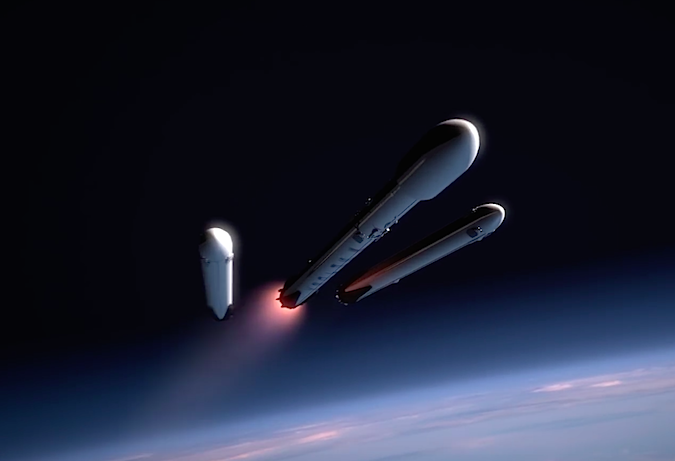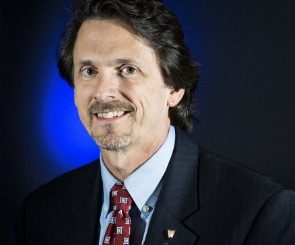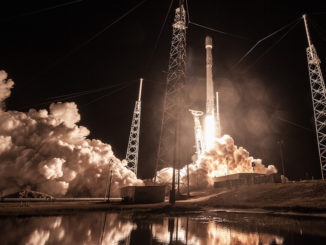
When SpaceX’s Falcon Heavy rocket finally takes off for the first time, a debut now scheduled this fall, there’s a good chance the commercial heavy-lifter will falter short of reaching orbit, company founder and chief designer Elon Musk said last week.
The oft-delayed test flight of SpaceX’s largest rocket to date, and the most powerful present-day launcher, will take off from pad 39A at NASA’s Kennedy Space Center in Florida, a storied seaside facility that served as the departure point for Apollo moon landing missions and most of the space shuttle’s trips into orbit.
SpaceX has not released a target launch date for the Falcon Heavy’s first flight, but the company expects it to be ready to take off before the end of December, around four years later than the rocket’s originally planned debut.
The rocket’s development proved more challenging than anticipated, Musk said July 19 at the International Space Station Research and Development Conference in Washington.
“I think Falcon Heavy is going to be a great vehicle,” Musk said. “There’s just so much that’s really impossible to test on the ground, and we’ll do our best. It actually ended up being way harder to do Falcon Heavy than we thought.”
Made up of three modified rocket cores derived from SpaceX’s current Falcon 9 rocket family, the Falcon Heavy will blast off with 27 Merlin 1D main engines, nine each on a central stage and two side-mounted boosters.
“At first it sounds real easy, you just stick two first stages on as strap-on boosters, but then everything changes,” Musk said. “All the loads change, aerodynamics totally change. You’ve tripled the vibration and acoustics. You sort of break the qualification levels on so much of the hardware.”
The two side boosters on the first flight are reused Falcon 9 rocket stages that flew on missions last year, but with aerodynamic nose cones. The core booster, which is also based on the Falcon 9 design, is a new build, fitted with mounting brackets, attachment mechanisms and structural enhancements to accommodate the extra stress of a Falcon Heavy launch.
“The amount of load you’re putting through that center core is crazy because you’ve got two super-powerful boosters also shoving that center core, so we had to redesign the whole center core airframe,” Musk said. “It’s not like the Falcon 9 because it’s got to take so much load. Then you’ve got separation systems.”
The side boosters will jettison from the Falcon Heavy’s core around two-and-a-half minutes after liftoff, then return to land at Cape Canaveral Air Force Station, where SpaceX is upgrading its rocket landing zone for two simultaneous touchdowns.
Meanwhile, the center booster will continue firing a bit longer before switching off its nine Merlin engines and dropping back through the atmosphere for a landing on SpaceX’s rocket recovery barge in the Atlantic Ocean.
An upper stage similar to the Falcon 9’s will take over to drive into orbit. SpaceX has not disclosed the exact profile for the Falcon Heavy’s inaugural flight, but it is expected to include multiple firings of the second stage’s single Merlin engine to demonstrate in-space maneuvering required on future missions by the heavy-duty launcher.
The demonstration flight will not carry a customer payload.
“Falcon Heavy requires the simultaneous ignition of 27 orbit-class engines,” Musk said. “There’s a lot that can go wrong there.
“I encourage people to come down to the Cape to see the first Falcon Heavy mission,” he added, hinting at the riskiness of the launch. “It’s guaranteed to be exciting.”
Before rolling the Falcon Heavy out to pad 39A, SpaceX will have tested each of the three boosters individually. But a hotfire test at pad 39A in the run-up to the maiden flight will be the first time all 27 engines will ignite in unison, building up to 5.1 million pounds of combined thrust.
SpaceX does not have a test stand at its Central Texas development site to support such a high-thrust firing.
“This is one of those things that’s really difficult to test on the ground,” Musk said. “We can fire the engines on the ground, and we can try to simulate the dynamics of having 27 instead of nine booster engines, and the airflow as it goes through transonic (as it exceeds the speed of sound). It’s going to see heavy transonic buffet. How does it behave at Max-Q (maximum dynamic pressure)?
“There’s a lot of risk associated with Falcon Heavy, a real good chance that that vehicle does not make it to orbit,” Musk said, referring to the inaugural test launch. “I want to make sure to set expectations accordingly. I hope it makes it far enough beyond the pad so that it does not cause pad damage. I would consider even that a win, to be honest.”
The Falcon Heavy will weigh more than 3.1 million pounds (1.4 million kilograms) fully loaded with kerosene and liquid oxygen propellants and stand more than 229 feet (70 meters) tall.
“The nice thing is when you fully optimize it, it’s about two-and-a-half times the payload capability of a Falcon 9,” Musk said. “It’s well over 100,000 pounds to LEO (low Earth orbit) of payload capability, 50 tons. It can even get up a little higher than that if optimized.”
If the demo mission gets off the ground successfully by the end of this year, two more Falcon Heavy flights are on the books in the first half of 2018, both from Florida.
SpaceX will shift its Florida launch operations to nearby pad 40 as soon as September to allow construction crews to finish readying pad 39A for the Falcon Heavy. The upgrades include beefing up the transporter-erector, which holds the rocket as it climbs on rails up the ramp leading from SpaceX’s hangar to the pad 39A launch mount, then doubles as an umbilical tower during countdowns.
Crews this summer are repairing pad 40 after a SpaceX rocket exploded there last September, severely damaging the launch complex and forcing the company to shift all its Florida liftoffs to pad 39A.
Email the author.
Follow Stephen Clark on Twitter: @StephenClark1.



